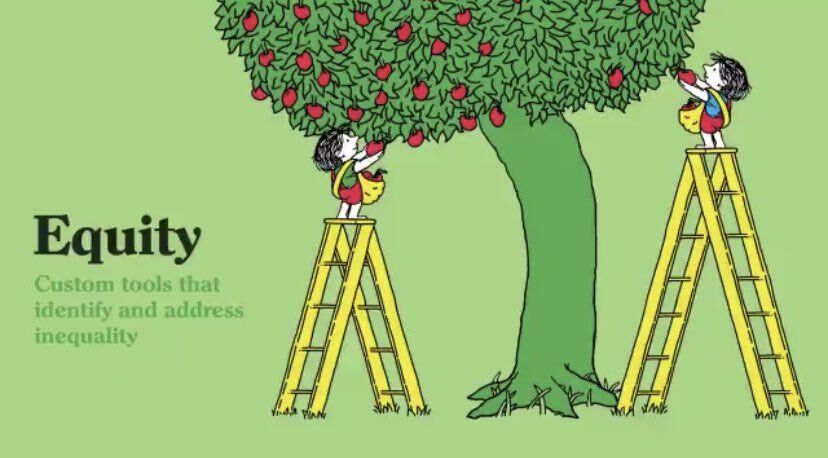Justice
Some useful resources for exploring social and environmental justice issues.
These illustrations were done by an artist called Tony Ruth @lunchbreath and are an adaptation of the illustrations in the children’s book The Giving Tree by Shel Silverstein.
In these pictures the tree is being used as a metaphor for the social economic system to illustrate the inequality of the current system, which leans towards one boy and away from the other. It argues that giving both boys equal access to tools, but not opportunity, isn’t true equality. It shows that to get round this and create equity, we can give the boy specialised tools that help him better access the benefits of system that is rigged against him (he can reach the tree, but only the branches with the fewest apples), but justice is when the system is re-balanced so that the boys have equal access and opportunity.
Now, if we stop thinking of the tree as a metaphor and think about it as a tree, what this shows is the establishment of ‘environmental justice’ – or at least one definition it. It is environmental justice focused on trying to create a fair distribution of environmental ‘goods’ and making sure that environmental ‘bads’ are not unfairly shared and that those who cause environmental problems carry their fair share of the burden of responsibility for dealing with them.
This helps us to think about questions like who are protecting the environment for?
Examples of environmental injustice are:
(a) When one group(s) benefits from environmental plunder (material goods, cheap fuel, food, water, etc, etc) and other groups don’t. (e.g. it is not fair that one child gets all the apples)
(b) When one group(s) has access to environmental goods (clean air, nature, wildlife, etc, etc) and other groups have to live with environmental bads (air pollution, climate change impacts [floods, droughts, storms, landslides, etc], habitat destruction, toxic waste, etc).
To achieve environmental justice, these injustices need to be addressed. This usually means re-jigging the social-environmental system in some way.
In this view of environmental justice, however, the tree only has ‘instrumental value’ – i.e. we are only thinking about what we can derive from the tree. What it does not take into account is the ‘intrinsic value’ of the tree – i.e. the tree has a value independent of humans. As does a wild animal, a river, a mountain, an ocean.
In reality the relationship we have with nature is a relational one, we respect its intrinsic value, but we also value it instrumentally. This broadens our definitions of environmental justice, because it makes us consider the rights of nature itself - its landscapes, plant species, animal species and so on.
From a paper by Kai Chan et. al. (2016) Why protect nature? Rethinking values and the environment.
This is at the root of the tensions that sometimes exists between the conservation, environmental and social justice movements. They might all make different cases for maintaining or changing the way humans relate to a particular environment, environmental resource, or way of managing an environment.
In the hills of mid-Wales, for example, some people want to conserve the traditions and aesthetics of sheep farming, others want to turn that land over to commercial forestry to create jobs and economic growth, while another group want to re-wild the uplands. This can lead to tensions, and requires us to find compromises.
Exercise
Read ‘The Giving Tree’ by Shel Silverstein, or watch the youtube version. It shows one way of relating with the tree. Discuss the moral of the story (it is explored in this forum). Now thinking about the other boy in Tony Ruth’s pictures above, write an alternative version of The Giving Tree (you might even want to re-title the story).





